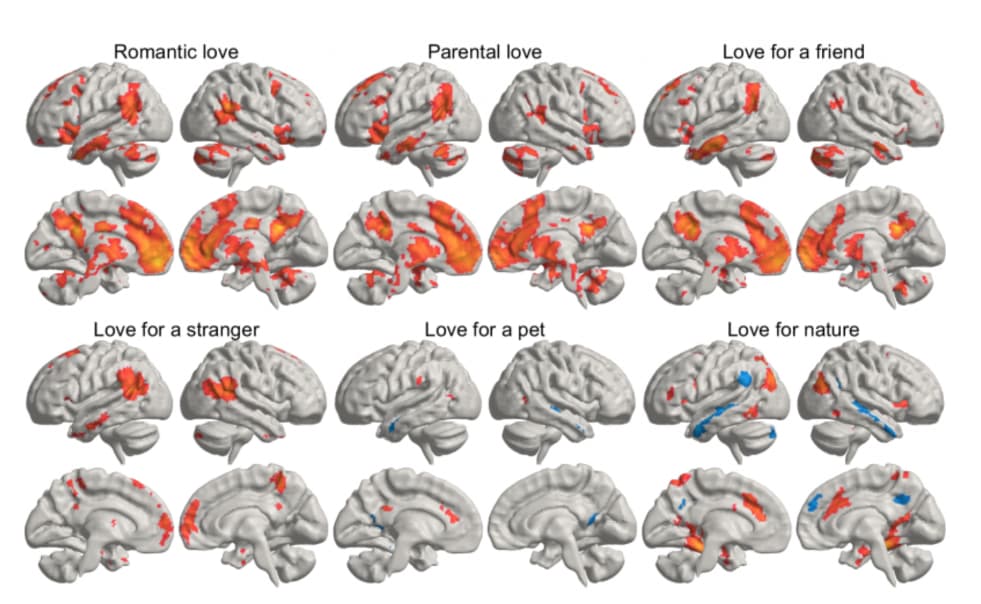Brain mapping study reveals neural signatures of different types of love
A groundbreaking neuroimaging study has identified distinct patterns of brain activation associated with various forms of love, offering new insights into the neural underpinnings of this complex emotion.

The image represents a statistical average of how different types of love light up different regions of the brain. © Pärttyli Rinne et al 2024, Aalto University
Love, in its myriad forms, has long captivated philosophers, poets, and scientists alike. Now, researchers from Aalto University have shed new light on how different types of love manifest in the brain, potentially paving the way for enhanced understanding and treatment of attachment disorders, depression, and relationship issues.
The study, published 26 August 2024 in the journal Cerebral Cortex [1], utilised functional magnetic resonance imaging (fMRI) to map brain activity in 55 parents who self-identified as being in loving relationships. Participants were presented with brief scenarios depicting six distinct types of love: parental, romantic, friendship, compassion for strangers, love for pets, and love of nature.
Neural signatures of love
The research team, led by philosopher and researcher Pärttyli Rinne, found that love consistently activated several key brain regions across different scenarios. “The activation pattern of love is generated in social situations in the basal ganglia, the midline of the forehead, the precuneus and the temporoparietal junction at the sides of the back of the head”, Rinne explained.
However, the intensity and specific patterns of activation varied depending on the type of love being experienced. Parental love, for instance, elicited the most intense brain activity, closely followed by romantic love.
“In parental love, there was activation deep in the brain’s reward system in the striatum area while imagining love, and this was not seen for any other kind of love,” Rinne noted.
Interpersonal vs non-human love
One of the study’s most intriguing findings was the distinction between brain activity associated with interpersonal love and love directed towards non-human entities such as pets or nature.
Love for other humans consistently activated areas of the brain associated with social cognition, regardless of the specific relationship type. In contrast, love for pets or nature engaged different neural circuits, with one notable exception.
The pet factor
Interestingly, the researchers discovered that they could statistically identify pet owners based on their brain responses to scenarios involving love for animals. “When looking at love for pets and the brain activity associated with it, brain areas associated with sociality statistically reveal whether or not the person is a pet owner. When it comes to the pet owners, these areas are more activated than with non-pet owners,” Rinne observed.
This finding suggests that for pet owners, the bond with their animal companions may activate social cognition networks in a manner more similar to interpersonal relationships than previously thought.
Methodology and control
The study employed a carefully designed methodology to isolate the neural signatures of love. Participants listened to professional recordings of “love stories” and were then asked to imagine and experience the associated emotions for ten seconds.
To control for non-love-related brain activity, the researchers included neutral scenarios, such as looking out of a bus window or brushing one’s teeth absent-mindedly.
Implications for mental health and philosophy
While the primary focus of the study was to map the neural correlates of different types of love, the findings have potential implications beyond neuroscience. The researchers hope that their work will contribute to the development of more effective mental health interventions, particularly for conditions involving attachment and relationship difficulties.
Moreover, the study may inform philosophical discussions about the nature of love, consciousness, and human connection. By providing empirical data on the neural mechanisms underlying various forms of love, the research offers a new perspective on age-old questions about the essence of human emotions and relationships.
This study builds upon previous work by Rinne and his colleagues, including research mapping subjects’ bodily experiences of love. The team’s ongoing efforts to deepen our scientific understanding of human emotions promise to yield further insights in the future.
Reference:
Rinne, P., Lahnakoski, J. M., Saarimäki, H., et. al. (2024). Six types of loves differentially recruit reward and social cognition brain areas. Cerebral Cortex, 34(8), bhae331.
https://doi.org/10.1093/cercor/bhae331

